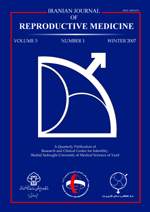
|
International Journal of Reproductive BioMedicine
Research and Clinical Center for Infertility, Shahid Sadoughi University of Medical Sciences of Yazd
ISSN: 1680-6433
EISSN: 1680-6433
Vol. 6, No. 3, 2008, pp. 143-148
|
 Bioline Code: rm08023
Bioline Code: rm08023
Full paper language: English
Document type: Research Article
Document available free of charge
|
|
|
International Journal of Reproductive BioMedicine, Vol. 6, No. 3, 2008, pp. 143-148
| en |
Assessment of testis histological changes and sperm parameters in experimentally–induced unilateral and bilateral cryptorchid mouse model
Absalan, Forouzan; Movahedin, Mansoureh & Mowla, Seyed Javad
Abstract
Background:
In most mammals, the testis is always maintained at a lower temperature
than that in the abdomen, and exposure of the testis to body temperature causes
degeneration of germ cells.
Objective:
In this research, the long effect of heat exposure on sperm parameters and
microstructure of mouse testis were investigated. Cryptorchid mouse were induced by
exposure to abdominal heat.
Materials and Methods:
Immature mice were anesthetized and a small incision was
made in the abdominal skin, then fat pad at the upper end of testis was sutured to
peritoneum. Weight of testis, spermatogenic cell numbers, tubular ectasis (rate of
tubular lumen comparing to the thickness of germinal epithelium) as well as epididymal
sperm parameters were measured.
Results:
The results showed that spermatogenesis was arrested and testicular weights,
seminiferouse tubular diameters and epididymal sperm parameters were significantly
reduced in the bilateral undescended testis compared with unilateral undescended testis
and the control mice. However, complete depletion of seminiferous tubules and absence
of germ cells was not found in the animals.
Conclusion:
In general, high temperature caused a decreased in all analyzed parameters
except spermatogonial cell number probably due to the apoptosis and these changes
significantly increase in bilateral groups compared with unilateral groups. We believe
that the present model is a suitable tool for enrichment of spermatogonial stem cells,
also it is useful for treatment of cryptorchidism and further biological research on
spermatogenesis.
Keywords
Cryptorchidism, Testis, Spermatogonial stem cells.
|
| |
© Copyright 2008 - Iranian Journal of Reproductive Medicine
Alternative site location: http://www.ijrm.ir
|
|
